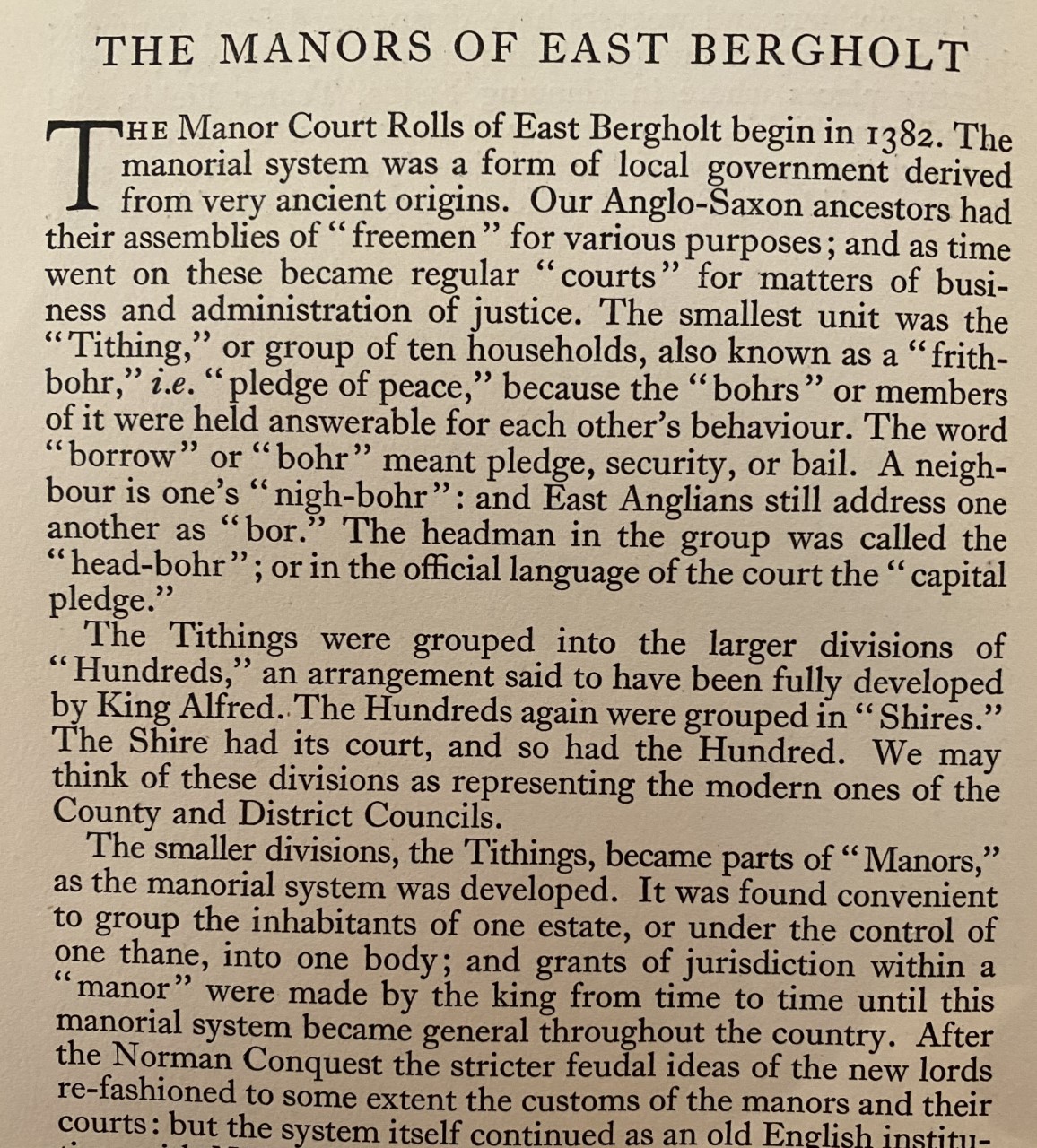The Four Manors of East Bergholt
The parish of East Bergholt is just over 3000 acres and by Anglo Saxon times it was a well established community. It was divided into four manors with Old Hall the principal manor containing part of Flatford hamlet. In the Domesday Book of 1084 it is recorded as the royal parish of ‘Bercolt’, which means it was held as the personal property of the king.
- 51
- Old Hall | Spensers, or Spencers | Illaries, or New Hall |St Johns, or the Commandery
Details
East Suffolk is mainly an agricultural area but until the end of the 16th century also very involved with the cloth trade.
OLD HALL & ILLARIES MANOR
Flatford – Two Manors
Flatford was part of two manors, Old Hall and Illaries.
- The task of finding the history of Old Hall manor is made difficult by the poor condition of many rolls and by the fact that until 1734 the information recorded in court rolls was in Latin.
- The Old Hall Rolls (which begin in 1382) recorded most major decisions relating to the property, the inhabitants and incidents occurring in the manor.
- During The Peasants Revolt in 1381 the bailiff to the Old Hall manor was forced to produce most of the Court Rolls and they were publicly burnt in front of the church gate.
- The Illaries Court Rolls are in a much worse state – only excerpts exist and they cover only very limited periods!
Flatford Buildings
The principal buildings in Flatford are timber framed which are good examples of a range of early buildings. These are:
- Bridge Cottage – a small cottage, typical accommodation for a family working on the river, in the mill or on the land – much altered over hundreds of years.
- Valley Farm – a rich persons house possibly belonging to a clothier or farmer or someone who was both.
- Willy Lott’s House – a farmhouse
Early Human Activity
The earliest sign of human activity in Flatford is a site about 150 yards downstream of Willy Lott’s which was later known as the Swans’ Nest. In his book, published in 1923, Rev Paterson describes it as being a rectangular enclosure about 45 by 32 yards surrounded by a wide moat. He considered that it was a defensive position built perhaps by the Romans or Anglo Saxons to prevent boats moving upstream.
Population of Flatford
It is unlikely that the number of cottages and houses in Flatford today would have been sufficient to accommodate the number of work people and their families needed to work the local farms, the mill and the river activities. Although firm evidence is rare, there are some pointers:
- The Domesday Book records East Bergholt parish as having two churches which suggests a relatively large population, but where was the second church? J.F.Elam in his book about St Mary’s points out that “the relevant parts of the document are unusually ambiguous”. This means that the second church could have been in Shelley, which was part of the Manor of Bergholt as were some other villages.
- The William Brasier map of 1731 named the field adjacent to Valley Farm in Flatford, as Church Field, suggestive that a church had once stood in Flatford in this field. In addition he shows “The Old Parsonage” on Glebe land just to the north east of Haybarn. This is supported by a 1986 aerial photograph which shows a clear cropmark in the same position. In the days when travel was on foot or horse back it’s very unlikely that the Rector of St Mary’s would have lived in Flatford so far from the majority of his congregation.
- In 1714 the Reverend Edward Alston had moved the rectory to the ‘New Rectory’ (now known as the ‘Old Rectory’) in Rectory Hill, East Bergholt.
- Recently-found evidence would support the theory that there was a church in Church Field but the theory remains unproven.
- In 1562 there were three water mills in Flatford, two of which were probably involved with the cloth trade. During that era Flatford would have been a small industrial centre for the trade, employing many people. East Bergholt had a number of clothiers (In the early C17 there were 14 clothiers) and as a result had become very rich.
Peter Tonks and Simon Gallup 2020 for more information about early Flatford please cliek HERE
ST JOHNS, COMMANDERY & SPENCERS MANORS
Both ‘St Johns’, otherwise known as Commandery, and ‘Spencers’ Manors were created during the reign of Henry II (1154-1189), however unlike Old Hall and Illaries there were no direct links to Flatford.
The Four Manors were situated:
· MANOR OF OLD HALL (Principle Manor)
· MANOR OF SPENSERS OR SPENCERS
Its manor house originally located on the site of a Tudor Cottage, Mission Lane, East End.
· MANOR OF ILLARIES, or NEW HALL
With its manor house was on the site of Manor Farm, East End.
(At one time Edward Lamb was Lord of this manor. He founded lamb school in 1594).
· MANOR OF ST JOHNS, OR THE COMMANDERY.
Situated close to the site of White Horse Farm at the bottom of Mill Road, an area known on the old heath as ‘Bakers End’
N. Reed
- 51
- Old Hall | Spensers, or Spencers | Illaries, or New Hall |St Johns, or the Commandery

